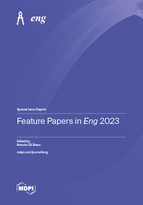Development and Applications of 3D Printing-Processed Auxetic Structures for High-Velocity Impact Protection: A Review
Round 1
Reviewer 1 Report
Comments for author File: ![]() Comments.pdf
Comments.pdf
Author Response
Dear Reviewer,
Attached is a Response to Reviewers containing the point-by-point responses to each of the four reviewers' comments. The authors thank you for your attention in evaluating the manuscript and making comments that contributed to the improvement of the work.
Author Response File: ![]() Author Response.pdf
Author Response.pdf
Reviewer 2 Report
In this manuscript, the authors reviewed the auxetic structures from the view of materials, structures, additive manufacturing process and applications. There are a number of references of 227 articles to support the review article. It is shown that the topic is a hot point of lighter and stronger structures. However, given that auxetic structures manufacture has been performed over a long time from 1800‘s, the authors should emphasize the novelty of their proposed the application of high-velocity impact protection.
1) In this manuscript, what is the range of velocity is defined as high-velocity impact? In this circumstance, what 3D printing method, materials and auxetic structures scale can fulfil the application?
2) Some terminology and definition used in the manuscript is not the newest. The author should check the definition of ISO/ASTM 52900:2021. eg. microstereolitography (SLA) in line 414 should be vat photopolymerization in the ISO/ASTM. Please check the other terminology in the article.
3) The application part has some mistakes such as some Table number missed in line of 558, 560. As the part of 5.2. Military High-Velocity Impact applications is the key point of the topic, it need to be more detailed.
Thus, this manuscript could be accepted for publication after the revision of the manuscript.
Author Response
Dear Reviewer,
Attached is a Response to Reviewers containing the point-by-point responses to each of the four reviewers' comments. The authors thank you for your attention in evaluating the manuscript and making comments that contributed to the improvement of the work.
Author Response File: ![]() Author Response.pdf
Author Response.pdf
Reviewer 3 Report
The present review comprehensively discusses the 3D-printed AXSs published in the recent studies, as well as their applications. I recommend this article published, however, revisions should be careful considered before acceptance.
1. Section “2. Auxetic Materials” should be re-organized. In this section, there is only one subheading (Properties of Auxetic Structures), which can be deleted. Moreover, the author should focus on the materials in this section, as the title of this section indicates. However, the author provides background of materials properties. Therefore, the author should make it clearer.
2. Figures in this manuscript should be improved. It would be better to provide more information in each figure. For example, in Figure 17, there are two structures. It is suggested to use two colors to present different structures?
3. For the Section 4 (AM of Auxetic Materials), do you mean Auxetic structures rather than materials?
4. The classification of AM techniques in Section 4 is not professional. I suggest the author refers to other papers. For example, self-assembly and CVD are actually not AM techniques only if you can justify reasonably.
5. In the Line 440, SLA uses photopolymer rather than AA606 aluminum alloy to print RCA. Please check.
6. The abbreviation of stereolithography is SLA, and the abbreviation of microstereolithography is µSLA.
7. There are some errors in the Line 560 and 558.
8. In Section “5. Applications”, Section “5.1 General Applications” can be used as introduction in the Section 5.
Author Response
Dear Reviewer,
Attached is a Response to Reviewers containing the point-by-point responses to each of the four reviewers' comments. The authors thank you for your attention in evaluating the manuscript and making comments that contributed to the improvement of the work.
Author Response File: ![]() Author Response.pdf
Author Response.pdf
Reviewer 4 Report
This paper is a more complete and comprehensive review, with a logical progression between chapters, and I would propose that it be published with minor modifications.
1. Figure 2 and the text above are not necessary in the review in my opinion.
2. Equations 1-3 are common formulae and are recommended for deletion.
3. Line 558 should be Table 3.
4. The article summarises more than 200 references, which is a huge amount of work, but the conclusion and perspective sections are still very weak and inadequate to summarise. It is suggested that the article be summarised separately at the end according to the chapters of the paper.
Author Response
Dear Reviewer,
Attached is a Response to Reviewers containing the point-by-point responses to each of the four reviewers' comments. The authors thank you for your attention in evaluating the manuscript and making comments that contributed to the improvement of the work.
Author Response File: ![]() Author Response.pdf
Author Response.pdf





